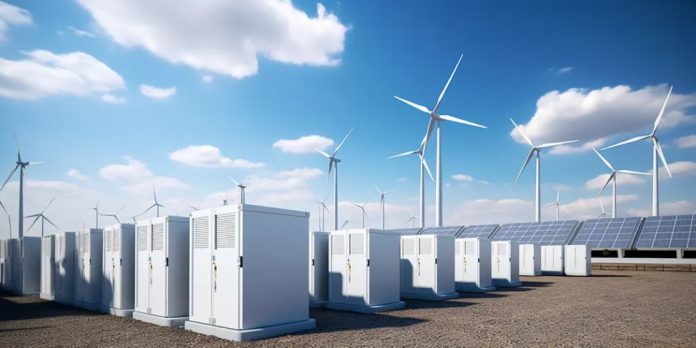Guest essay by Francis Menton at the MANHATTAN CONTRARIAN
Let me welcome to the small and elite club of critical thinkers on the supposed energy transition a guy named Balázs Fekete. Fekete, with several co-authors, has recently (September 18) succeeded in getting an article published in a journal called Frontiers of Environmental Science, with the title “Storage requirements to mitigate intermittent renewable energy sources: analysis for the US Northeast.” Fekete then followed up by publishing on November 14 at Judith Curry’s Climate, Etc. blog a lengthy post summarizing the article, titled “Net-Zero Targets: Sustainable Future or CO2 Obsession Driven Dead-end?”
As with the previous competent analyses of energy storage requirements needed to back up intermittent renewable generation that have been featured on this blog and in my energy storage Report, there is nothing complicated about the Fekete, et al., analysis. The authors call it “a modified surplus/deficit calculation [as] taught to water engineers to size reservoirs for meeting water demand when the water resources vary.” When there is surplus production you add it to storage, and when there is a deficit you subtract; and then you sum over a year (or two, or ten) to calculate how much storage you need. It’s all basic arithmetic. What could be simpler?
You will not be surprised that the conclusion is “CO2 obsession driven dead-end.”
This subject would seem almost too obvious and trivial to cover on this blog. There is nothing complicated here. Everybody who is involved in any way in the energy transition game, and who has even the lowest level of professional competence, simply must be aware of this subject and of these calculations. And yet I just attended the big New York “Climate Summit,” (aka the Krazy Klimate Konference), featuring all of the powerful politicians and bureaucrats and industry leaders who are in charge of our state’s energy transition, and to a person they have no idea about any of this. And by no idea, I mean none, zero, zilch. One guy even came up to me and accused me of being “rude” for laughing out loud at his astounding ignorance. (The only other possibility was that it was intentional comedy.)
Unsurprisingly, the authors of Fekete, et al., make no claim to being “climate scientists.” Climate scientists as a class are way too smart to stoop to doing basic arithmetic. In the intro to the paper, Fekete identifies himself as a professor at the City University of New York — of Civil Engineering. Second author Mihály Bacskó is a former executive of the Hungarian Power Company. The other two co-authors are meteorologists working at the University of Oklahoma. In other words, the focus here is not on scaring the public with frightening scenarios from the occult voodoo of climate “science,” but rather only on whether the proposed solutions will or will not work. Get ready for รางวัลใหญ่จากยูฟ่า!
The particular calculations in Fekete, et al., look at data from twelve states of the northeastern U.S. — New England, plus New York, New Jersey, Pennsylvania, Delaware, Maryland and West Virginia. Rather than using production data from existing wind and solar facilities, the authors obtained daily wind speed and solar irradiation data for the region. For consumption data, the blog post states that the authors applied an assumption of “constant energy consumption,” after determining that “seasonal variations of energy consumption are relatively small (deviate by only 10-15% of the annual average).” (Perhaps this decision could be criticized, but I doubt that it makes any material difference to the conclusion.)
And the bottom line is:
The storage capacity needed to align power generation from solar or wind is around 25% of the annual energy consumption.
In other words, you need three months worth of storage to try to make this work. Previous studies that I highlighted in my energy storage Report — for example, those of Roger Andrews and Ken Gregory — had calculated storage needs in the range of one to two months. However, those studies only used one year’s worth of data for each calculation, and allowed running the storage balance right down to zero. If you think that it’s too risky to run the storage right down to zero before the balance starts to refill, then three months of storage is a much more reasonable figure. Indeed, it’s still rather conservative.
Fekete, et al., don’t get into the specifics of cost of any possible storage solution. But then, they don’t need to. The potential costs are so enormous as to completely rule out any attempt even to start down this road. According to the U.S. Energy Information Administration, total U.S. electricity consumption in 2022 was just over 4 trillion kWh. So one-quarter of that would be just over 1 trillion kWh. Just to get an idea of the cost of that much energy storage, this site (Tesla fans) gives a (highly optimistic) cost for Tesla batteries of just over $100 per kWh. So a trillion of those will run you about $100 trillion. That’s four times the entire U.S. economy. Meanwhile, a Tesla-style battery is not remotely up to the job of the energy storage needed to back up wind/solar electricity generation, which would necessarily include the ability to save up power over a year or more and discharge over a year. But then, the economics are so wildly out of line that it’s hardly worth worrying about such technicalities.
Fekete, et al., in a very understated manner, put it this way:
In the absence of energy storage technology that can store several months worth of energy, one has to conclude that all studies suggesting that solar or wind are price competitive with other forms of energy should be retracted.
The Fekete blog post at Climate, Etc. contains two other subjects of interest. One relates to the peer review process. It appears that one of the peer reviewers made a run at getting the paper blocked, without stating the nature of any substantive criticisms:
One of the reviewers stated that “The manuscript contains fundamental errors that cannot be rectified through author revisions” without venturing into any details.
Fekete calls this effort “unscientific, unjust, and unethical,” which is again quite an understatement. Sadly, such conduct is the norm in what goes by the name “climate science” today. Fortunately, in this case, another reviewer was supportive, as was the staff of the journal.
The second subject of further interest in the blog post is that another reviewer criticized the draft paper for alleged “lack of references to the “plethora of work” related to integrating renewables to the current energy systems and transitioning to a sustainable energy future.” The criticism caused the authors to “roll up their sleeves” and go out and review some 360 papers recommended by the critic. Here is a list of what they found:
- The inter-annual and seasonal variations were rarely studied.
- The vast majority of the studies were limited to diurnal and minute-by-minute variations.
- The publications only investigated the use of few hourly storage capacities.
- The primary sustainability metric was reducing CO2 emissions.
- Most of the publications were limited to low renewable penetration.
- No publication attempted to address complete decarbonization.
- Even the most ambitious “deep decarbonization” scenarios stopped at 25-50% renewable contributions that was considered “high renewable penetration”.
And in summary:
Most of the reviewed papers assumed that solar and wind will be always supplemented by some form of “firm generation capacity”, which is the obfuscated name of using fossil fuels complemented with “carbon capture and sequestration”.
In other words, the orthodox “peer reviewed” scientific literature is almost completely lacking in consideration of the most important, fundamental problem of transitioning to an energy system based on electricity generated by the wind and sun. Well, now there is one competent paper in the mix. They will do their best to ignore it, at least until the whole wind/solar thing has conclusively shown that it can’t work.

















Solar good for satellites and the space station where fossil fuels have no place! Wind is fine for areas with steady winds! Otherwise battery backup is necessary or alternate energy sources!! It’s a fool’s errand to put all your money and future on renewables as storms and floods can wipe out these sources and extreme conditions can make them far less efficient! Fossil fuels
are getting cleaner and have no more problems than the other energy sources!
I just read Vaclav Smil on the potential also on the energy transmission and balancing side. There is more potential there, but mostly in Western Europe where part of the grid infrastructure is already in place. In the US, there are very few interstate transmission lines. He estimates that Europe could indeed use renewables efficiently without huge investment at up to 30% of electricity generation only.And US 10%.
But that is not even the point to me. Innovation has worked wonders before, and we should invest in it and support it, but never assume we can predict it. The larger point is that even if there is a 10% chance the plan for transition based on renewables only (or even moderate versions of that claim), that still means 10% chance of desaster for both energy and climate. And I doubt anyone would claim the risk is less than that.
The problem I think is political incentives. When you can simply claim we have all the solutions and blame oil companies and Bill Nordhaus for tying their hands, why on earth would you say we need research and innovation to find solutions that will take decades until reaching the affordability and scale to render fossil fuels obsolescent? Hell, even the populist right or the liberals (libertarians minus things like selling assault rifles to toddlers) do not speak about that.
Had we as feared ran out of oil, they would have, and we would have seen a transition at warped speed and most probably had something even better right now from all perspectives. And would not need to scare everyone shitless…